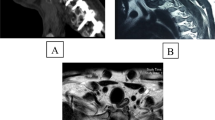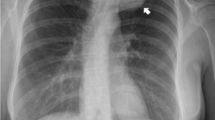Abstract
Objective. To determine the age distribution, gender, incidence, and imaging findings of vertebral chondroblastoma, and to compare our series with findings from case reports in the world literature.
Design and patients. Case records and imaging findings of nine histologically documented vertebral chondroblastomas were retrospectively reviewed for patient age, gender, vertebral column location and level, morphology, matrix, edema, soft tissue mass, spinal canal invasion, and metastases. Our findings were compared with a total of nine patients identified from previous publications in the world literature. The histologic findings in our cases was re-reviewed for diagnosis and specifically for features of calcification and secondary aneurysmal bone cyst (ABC). Clinical follow-up was requested from referring institutions.
Results. Nine of 856 chondroblastomas arose in vertebrae (incidence 1.4%; thoracic 5, lumbar 1, cervical 2, sacral 1). There were six males and three females ranging in age from 5 to 41 years (mean 28 years). Satisfactory imaging from seven patients revealed the tumor to arise from the posterior elements in four and the body in three. All tumors were expansive, six of seven were aggressive, and the spinal canal was significantly narrowed by bone or soft tissue mass in six. In one patient canal invasion was minimal. Calcification was pronounced in two and subtle in four. The sole nonaggressive-appearing tumor was heavily mineralized. Bony edema and secondary ABC were not seen on MR imaging. None of the cases had microscopic features of significant secondary ABC. Calcification, and specifically "chicken wire" calcification, was identified in two patients. Pulmonary metastases occurred in none.
Conclusions. Vertebral chondroblastoma is a rare neoplasm that presents later in life than its appendicular counterpart. On imaging it is aggressive in appearance with bone destruction, soft tissue mass, and spinal canal invasion. The lesions contain variable amounts of mineral. Secondary aneurysmal cyst bone formation was not a feature in our study group.
Similar content being viewed by others
Author information
Authors and Affiliations
Additional information
Electronic Publication
Rights and permissions
About this article
Cite this article
Ilaslan, H., Sundaram, M. & Unni, K.K. Vertebral chondroblastoma. Skeletal Radiol 32, 66–71 (2003). https://doi.org/10.1007/s00256-002-0599-4
Received:
Revised:
Accepted:
Issue Date:
DOI: https://doi.org/10.1007/s00256-002-0599-4




